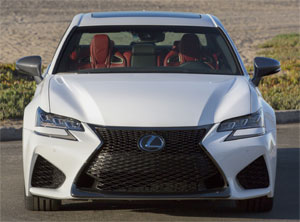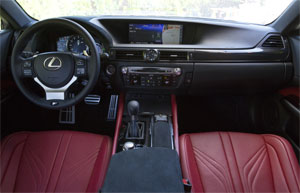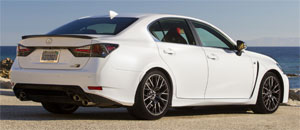2016 Lexus GS F
There have been many steps along Lexus’ path from posh to performance. The watershed one of course, was the LFA. But more recently, the IS F and RC F have helped to pick up the pace. Now there’s a new GS F for us to sample, and we’ve got a race track with many tasty turns on which to do so. Let’s see if it’s a perfect pairing for our well-seasoned palettes.
Ahh… Lexus. That purveyor of fine luxury goods that masquerade as transportation. Like any automotive brand, they’ve had their hits and misses over the years, and we’re still not sold on their current trend of putting a European performance bent to every model. But perhaps this 2016 Lexus GS F will change our opinion.
The powertrain is the same 5.0-liter V8 and 8-speed automatic transmission that has been kicking around since the 2008 IS F launched the F performance branding. But horsepower is now up to 467, and torque to 389 lb-ft.
Around Roebling Road Raceway’s high-speed twists and turns that engine sounds fantastic, even though that sound is largely synthesized. And it runs even better, with very linear feel and power delivery that seems torquier than its sibling the RC F coupe, even with identical numbers. Still, it’s nothing close to CTS-V levels of brutality.
 As for the chassis, well it’s completely competent and capable, yet not much more. Roll is subdued enough, but there’s just an overall soft feel that constantly reminds you you’re in a Lexus; as does the over 4,000-lbs of curb weight with 53% of it over the front wheels.
As for the chassis, well it’s completely competent and capable, yet not much more. Roll is subdued enough, but there’s just an overall soft feel that constantly reminds you you’re in a Lexus; as does the over 4,000-lbs of curb weight with 53% of it over the front wheels.
Still, it behaves mostly neutral with some mid-corner understeer to go along with throttle-on oversteer. The torque vectoring rear differential helps to tame that oversteer by transferring power to the rear wheel that will do the most good with it. You don’t really feel it working, but you clearly can tell the difference between Standard and Track modes.
The automatic transmission performs darn near like a sequential manual when in Sport S+ mode, with very quick gear changes when the steering wheel-mounted shifters are triggered.
Brakes were also solid, run after run; without any of the mushy feeling that usually arises in Lexus performance cars after a few hard laps.
Bottom line, we’ll call it a home run; but Lexus, drop some pounds and stiffen the suspension instead of relying on electronics to improve the handling and we might really have a grand slam.
But then, the GS F is not intended as a track car. To be one, the ultra-comfortable highway ride that Lexus owners expect would surely be history.
 Speaking of comfort, there’s a unique interior to enjoy as you effortlessly eat up those miles, and an incredible 17-speaker Mark Levinson surround sound system to help pass the time.
Speaking of comfort, there’s a unique interior to enjoy as you effortlessly eat up those miles, and an incredible 17-speaker Mark Levinson surround sound system to help pass the time.
F-exclusive gauges change themes according to Drive Mode, are easy to read at speed, and feature interactive displays like a G meter and lap timer.
Other special touches include the 3-spoke steering wheel, Heads-Up Display, aluminum-trimmed pedals, shift knob, carbon fiber trim, Metallic Dark Silver paint, Alcantara leather, and sport seats.
You definitely don’t want to be messing with the remote touch controller at speed as it’s hard to be precise with even at normal pace, but the infotainment system that it controls is very comprehensive.
Room inside is plentiful, and seats are top notch front to back. The GS F even retains all of its 14.0 cubic-ft. of trunk space.
The exterior gains some aero help by way of flared front fenders with grooved liners and air extracting vents, strategically placed under-trays, larger openings in the front fascia, sculpted rocker panels, unique side mirrors, and carbon fiber rear spoiler.
The quad tips of the stainless steel exhaust system, and available colors such as Molten Pearl, will surely shake things up in the Lexus showrooms. Lightweight 19-inch wheels with 255/35 tires up front and 275/35 rubber in the rear complete the package.
 You’ll have to walk gingerly on the gas pedal if you want to keep those rears from spinning up off the line, but a 4.5-second 0-60 is the result, when you do it just right.
You’ll have to walk gingerly on the gas pedal if you want to keep those rears from spinning up off the line, but a 4.5-second 0-60 is the result, when you do it just right.
Throughout the 13.0-seconds that it takes to complete a ¼-mile at 111 miles-per-hour, the GS F feels fiercely fast, yet still smooth and comfortable like a true luxury liner.
Likewise, shifts are about as fast as they can be without sacrificing smoothness.
Government Fuel Economy Ratings are 16-City, 24-Highway, and 19-Combined. The Energy Impact Score is just a bit worse than average at 17.3-barrels of yearly oil use with CO2 emissions of 7.8-tons.
The GS F is not exactly a performance bargain either, with base pricing of $85,390.
So the 2016 Lexus GS F may not be as big of a step up as other previous Lexus performance cars, but it is no doubt an important one. It’s well-seasoned enough to spice things up, without letting the performance flavor overwhelm the rest of the Lexus luxury dish. We predict the brand’s fans, old and new, will lap it up.
Specifications
- Engine: 5.0 liter
- Horsepower: 467
- Torque: 389 lb-ft.
- 0-60 mph: 4.5-seconds
- 1/4 mile: 13.0 seconds @ 111 mph
- EPA: 16 mpg city/ 19 mpg highway
- Energy Impact: 17.3 barrels of oil/yr
- CO2 Emissions: 7.8 tons/yr
2024 Toyota Land Cruiser
Toyota’s Go Anywhere Globetrotter Returns To U.S.
Every once in a while, we all need a reset. A time to get back to basics and prioritize the things that really matter. Well, for the Toyota Land Cruiser that time is now. So, let’s find out if that means bigger and better things for Toyota’s iconic off-roader.
The Toyota Land Cruiser’s status among the global off-road community is legendary, and it’s hard to imagine there’s any corner of the earth where a Land Cruiser hasn’t kicked up a little dust or mud. Well, 2024 sees the return of the Land Cruiser to the U.S. market after a 3-year hiatus, getting a major reset for the journey.
The reset comes mostly by no longer being based on the large three-row “300-series” chassis, but a new version of the smaller “200-series,” now known as the J250. As with the latest Tacoma, it uses the Tundra pickup’s full-size steel frame.
While the main Land Cruiser model, which goes by simply Land Cruiser, is packed full of luxury and convenience features, there is also a stripped-down model known as the 1958, honoring the first year the Land Cruiser made landfall here in North America. And it is that 1958 we have here, and we were glad to see it, as it also celebrates the original’s back-to-basics approach as a blank canvas for you to personalize as you tackle more and more adventures.
Not that it’s fully stripped down, as 8-inch touchscreen infotainment, a 7-inch full-color multi-information display, and automatic climate control are still standard. Plus, some seriously durable materials, and great heated cloth front seats that throw off some get serious 1990s Tacoma vibes.
But outside, there’s a definite lack of flashy trim and basic looking 18-inch wheels with Yokohama Geolander all-season tires; plus, big chunky bumpers and tilt-up back glass, which is a rarity that we appreciate. Though there is a little too much plastic in places that are sure to see some abuse if you do any significant off-roading.
It even feels a little rough around the edges, but for us it just adds to the rugged old-school utility vibe in a good way.
We did just that, both here in the Mid-Atlantic as well as in the California desert; and while there are some tech-forward driving aids, the actual hardware is in most cases plenty to get things done. That includes standard full-time dual-range four-wheel-drive, locking center and rear diffs, and 8.7-inches of ground clearance. A front stabilizer bar disconnect is also available to allow for increased articulation.
Who needs a V6 or even a V8 when you’ve got Toyota’s i-FORCE MAX setup at your disposal with 326 horsepower and 465 lb-ft of torque coming from a 2.4-liter turbo-four with an electric motor sandwiched between the engine and its eight-speed automatic transmission. Low speed torque delivery is impressive. It even feels a little rough around the edges, which may be a turn off to some, but for us it just adds to the rugged old-school utility vibe in a good way.
And it certainly feels quicker than an off roader needs to be, with an instant torque dump as soon as we eased on the throttle at our Mason Dixon test track; helping us get to 60 in 8.1 seconds and through the quarter-mile in 16.3 seconds at 86 mph. Considering the Land Cruiser’s terrain conquering mission, it behaved quite well in our handling course; it was plenty responsive to inputs, with less body roll than we expected and plenty of grip from the tires. The steering was light and quick but as expected didn’t provide much feel. Other than significant nosedive, braking performance was exceptional. Only 107-feet to panic stop us from 60 mph.
With the shift to the smaller size, there’s no more third row available, and cargo capacity now comes in at 46.2 cubic-feet with a max of a still healthy 82.1. Now, the best part of the Land Cruiser’s return is the entry price of $57,445. That’s about 30-grand less than what the last Land Cruiser went for back in 2021.
Whether it’s over the top fashion trends, mullets, or zombies; just when you think they’re dead, they come roaring back to life. Of course, we’re much happier to see the resurrection of this 2024 Toyota Land Cruiser than any of those things. Toyota is one brand that still recognizes the value of full-framed rugged rigs and has also acknowledged that sometimes less really is more. The Godfather of Toyota off-roading is back and better than ever.







